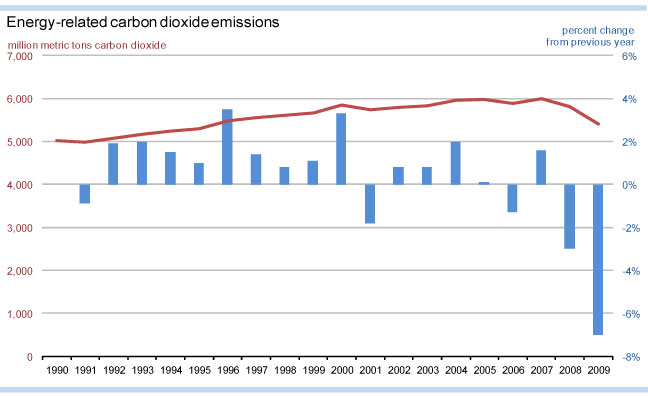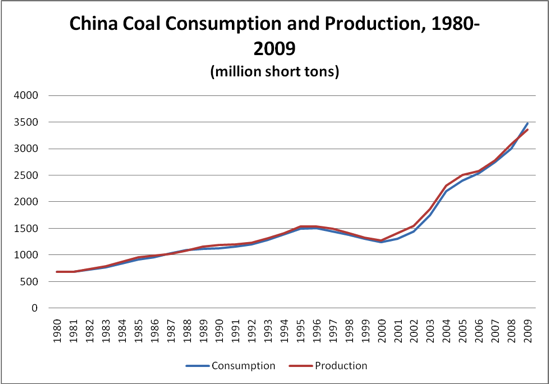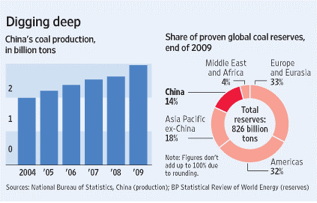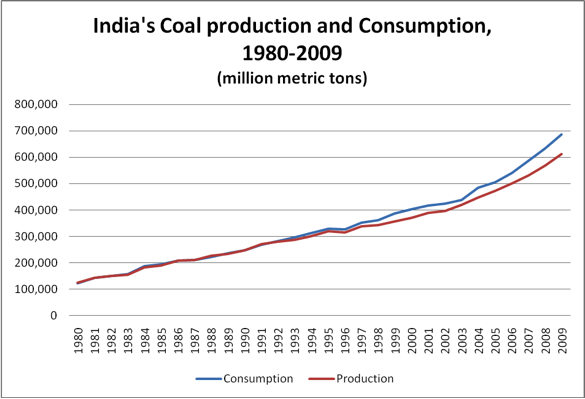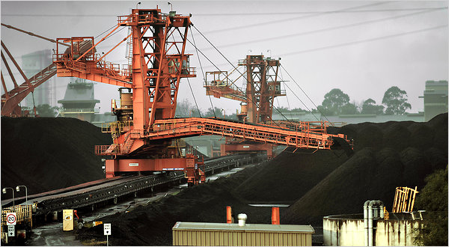According to the Global Carbon Project team[i], global carbon dioxide emissions dropped by 1.3 percent in 2009 from 2008 levels due to the weak world economy[ii], despite the growth in energy consumption by developing countries. China’s carbon dioxide emissions grew 8 percent in 2009, while India’s grew by 6 percent.[iii] In the United States, the drop in carbon dioxide emissions in 2009 was much larger than the 1.3 percent drop in world emissions.[iv] Carbon dioxide emissions in the United States were 7 percent lower in 2009 due to slow economic growth, a drop in energy demand of almost 5 percent, a drop in electricity generation of 4 percent, the use of more efficient technologies, and the addition of cleaner sources of energy (natural gas and renewable energy).[v] (See chart below.) This reduction was the largest decline in carbon dioxide emissions in the United States since data collection began in 1949.[vi] In the U.S. electric generating sector, fuel switching from coal to natural gas and renewable energy resulted from higher coal prices, lower natural gas prices, and subsidies for renewable energy.
Source: Energy Information Administration, http://www.eia.doe.gov/oiaf/environment/emissions/carbon/index.html
Shift in Countries Generating Carbon Dioxide Emissions
In 1990, the developed countries produced 65 percent of the world’s carbon dioxide emissions. Currently, those countries are producing less than 43 percent of the world’s carbon dioxide emissions. During that period, the developed countries have cut their emissions by 10 percent while the developing countries have more than doubled their carbon dioxide emissions.[vii] Developing nations were not affected by the recession as much as developed nations, and while making improvements in energy technology, developing nations are still not using energy as efficiently as developed countries.
China’s Dependence on Coal
According to the Energy Information Administration, China consumed 46 percent of the world’s coal consumption in 2009, an amount 3.5 times more than the United States consumed.[viii] In 2009, China became a net importer of coal when it imported 113 thousand more tons than it exported.[ix] While China ranks third to the United States and Russia in coal reserves, it holds only 14 percent of the world’s total.[x] Because of its reserve level and its large coal consumption, China is purchasing coal from Canada, Australia, South Africa, Indonesia, Columbia, and the United States. And, its imports of coal are growing. The United States alone exported over 1,000 times more coal to China In the first 6 months of 2010 (2.9 million metric tons) than it did in the first 6 months of 2009.[xi] These rising imports are to fuel China’s coal consumption that has grown by 180 percent between 2000 and 2009.[xii] This trend of China’s growing coal usage at over 10 percent annually does not bode well for the future of carbon dioxide emissions since China already is the largest emitter of carbon dioxide emissions and coal is the highest in carbon content of the three fossil fuels.
Source: Energy Information Administration, http://tonto.eia.doe.gov/cfapps/ipdbproject/iedindex3.cfm?tid=1&pid=7&aid=1&cid=&syid=1980&eyid=2009&unit=TST
In the three years to September 2010, Chinese companies spent $20.96 billion on coal-sector acquisitions overseas.[xiii] For Australia, coal exports to China grew to $5.6 billion in 2009 from $508 million in 2008. Australia’s largest export contract, $60 billion, was signed this summer with China Power International Development to supply coal to power stations in China beginning in 2013. The coal will come from mines in the Australian outback. Colombia, whose coal exports fell in 2008 and 2009 due to the economic recession, is expected to export 10 million tons of coal to Asia this year.[xiv] The United States, who is currently shipping its coal to China via Canadian ports, is contemplating building a port in the state of Washington as China is considering limiting its future growth in coal production to conserve its own coal resources.[xv]
India’s Coal Usage Is Also Growing
India is another emerging customer, whose coal usage is rising and must rely on its growing import market. According to the Energy information Administration, India’s coal consumption has been increasing at 6 percent per year since 2000,[xvi] and its net coal imports in 2009 were 74,000 short tons,[xvii] about two-thirds of China’s level. Although India is endowed with less coal reserves than China, with 7 percent of the world’s total,[xviii] its growing dependence on coal consumption will make it a growing contributor to carbon dioxide emissions.
The Sierra Club, who claims to have blocked 139 proposed coal plants in the United States, is not happy about Asia’s increased coal use. According to David Graham-Caso of the Sierra Club, “We don’t want this coal burned here, but we don’t want it burned at all. This is undermining everything we’ve accomplished.” [xix]
Source: Energy Information Administration, http://tonto.eia.doe.gov/cfapps/ipdbproject/iedindex3.cfm?tid=1&pid=7&aid=1&cid=&syid=1980&eyid=2009&unit=TST
Conclusion
Regardless of what the developed world does to reduce carbon dioxide emissions, the developing countries, particularly China and India, will continue their reliance on coal, the largest fossil fuel emitter of carbon dioxide. And, even if these countries do not have sufficient coal resources of their own, they will import from countries that have the coal resources. Thus, it makes no sense for the American public to be deprived of one of the most efficient sources of electricity: coal. It is time for environmental groups to stop blocking the construction of coal-fired plants in the United States since the coal will only be burned elsewhere.
[i] The Global Project Team was established in 2001 to track global carbon dioxide emissions and to perform research on the earth’s carbon cycle.
[ii]AP News, “Weak world economy reduces carbon pollution”, November 21, 2010, http://hosted.ap.org/dynamic/stories/U/US_SCI_CARBON_POLLUTION?SITE=FLSTU&SECTION=HOME&TEMPLATE=DEFAULT
[iii] Ibid.
[iv] Energy Information Administration, U.S. Carbon Dioxide Emissions in 2009: A Retrospective Review, May 5, 2010, http://www.eia.doe.gov/oiaf/environment/emissions/carbon/index.html
[v] Energy Information Administration, Monthly Energy Review, http://www.eia.gov/mer/pdf/pages/sec7_5.pdf and http://www.eia.gov/mer/pdf/pages/sec1_7.pdf
[vi] Energy Information Administration, U.S. Carbon Dioxide Emissions in 2009: A Retrospective Review, May 5, 2010, http://www.eia.doe.gov/oiaf/environment/emissions/carbon/index.html
[vii]AP News, “Weak world economy reduces carbon pollution”, November 21, 2010, http://hosted.ap.org/dynamic/stories/U/US_SCI_CARBON_POLLUTION?SITE=FLSTU&SECTION=HOME&TEMPLATE=DEFAULT
[viii] Energy information Administration, http://tonto.eia.doe.gov/cfapps/ipdbproject/IEDIndex3.cfm?tid=1&pid=1&aid=2
[ix] Energy information Administration, http://tonto.eia.doe.gov/cfapps/ipdbproject/IEDIndex3.cfm?tid=1&pid=1&aid=4 and http://tonto.eia.doe.gov/cfapps/ipdbproject/IEDIndex3.cfm?tid=1&pid=1&aid=3
[x] Energy Information Administration, International Energy Outlook 2010, Table 10, http://www.eia.doe.gov/oiaf/ieo/index.html
[xi] Energy Information Administration, Quarterly Coal Report, http://tonto.eia.doe.gov/cneaf/coal/quarterly/html/t7p01p1.pdf
[xii] Energy information Administration, http://tonto.eia.doe.gov/cfapps/ipdbproject/iedindex3.cfm?tid=1&pid=1&aid=2&cid=&syid=2000&eyid=2009&unit=TST
[xiii] The Wall Street Journal, China’s Coal Crisis, November 16, 2010, http://online.wsj.com/article/SB10001424052748704312504575617810380509880.html?mod=googlenews_wsj
[xiv] The New York Times, Nations that Debate Coal Use Export It to Feed China’s Need, November 21, 2010, http://www.nytimes.com/2010/11/22/science/earth/22fossil.html?_r=4&ref=todayspaper
[xv] The Wall Street Journal, China’s Coal Crisis, November 16, 2010, http://online.wsj.com/article/SB10001424052748704312504575617810380509880.html?mod=googlenews_wsj
[xvi] Energy Information Administration, http://tonto.eia.doe.gov/cfapps/ipdbproject/IEDIndex3.cfm?tid=1&pid=1&aid=2
[xvii] Energy Information Administration, http://tonto.eia.doe.gov/cfapps/ipdbproject/IEDIndex3.cfm?tid=1&pid=1&aid=4 and http://tonto.eia.doe.gov/cfapps/ipdbproject/IEDIndex3.cfm?tid=1&pid=1&aid=3#
[xviii] Energy Information Administration, International Energy Outlook 2010, Table 10, http://www.eia.doe.gov/oiaf/ieo/index.html
[xix] The New York Times, Nations that Debate Coal Use Export It to Feed China’s Need, November 21, 2010, http://www.nytimes.com/2010/11/22/science/earth/22fossil.html?_r=4&ref=todayspaper


